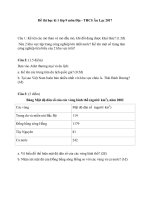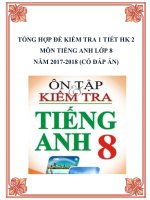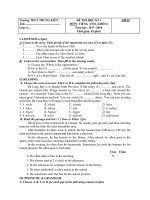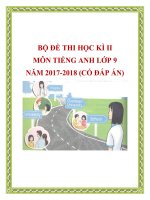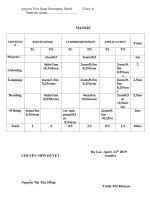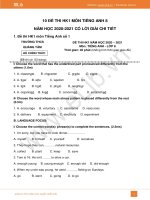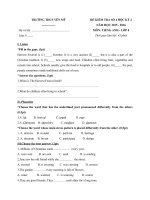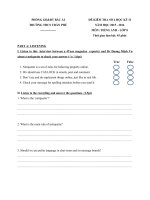Đề tham khảo thi giữa học kì 2 môn Tiếng Anh lớp 8 năm 2020-2021 có đáp án - Trường THCS Lê Quang Cường (Đề số 2)
Bạn đang xem bản rút gọn của tài liệu. Xem và tải ngay bản đầy đủ của tài liệu tại đây (327.37 KB, 6 trang )
PHONG GIAO DUC & ĐT TP BA RIA
̀
́
̣
̀ ̣
TRƯƠNG THCS LÊ QUANG C
̀
ƯỜNG
ĐỀ THAM KHẢO SỐ 2
ĐỀ KIỂM TRA GIỮA HỌC KỲ II
Năm học 20202021
Môn: Tiếng Anh – Khối 8
Thời gian làm bài: 50 phút
Date: ……….…2021
Class: 8A……
Name: ……………………………
The teacher’s remark
Points
I/ LISTENING (2,0pts)
Part 1: Listen to Philip talking to a friend about his photography course, then tick the best one.
(1.0pt)
1. What time do the photography classes begin ?
A. 5.15 p.m.
B. 6 p.m.
C. 6.45 p.m.
2. Philip’s happy with the course because he’s _______
A. learning about famous photographers.
B. using a new camera.
C. Getting better at photography.
3. Philip think it’s easy to take photographs of _______.
A. trees
B. animals
C. children
4. After the course, Philip will _______.
A. buy a new camera
B. get a job in photography
C. make photography his hobby.
Part 2: You will hear a man asking for information about the Westwood English school, then
complete the questions. (1.0 pt)
= = = = = WESTWOOD ENGLISH SCHOOL = = = = =
Evening classes on:
Thursday
Next course starts on: (1) 22____________
Speaking class with:
(2) Miss____________
Cost for 12 classes:
(3) £ ____________
School is next to the: (4) ____________
II/MULTIPLE CHOICES (2,5pts)
1. Find the word which has a different sound in the part underlined.
A. capital
B. liberty
C. empire
D. mingle
2. Choose the word which has a different stress pattern from the others.
A. dramatic
B. tornado
C. historic
D. injury
3. What would Tom do if he ____________the truth?
A. would know
B. has know
C. knows
D. knew
4. How many times have I told you ____________football in the street?
A. not to play
B. do not play
C. not playing
D. to be listening
5. I don’t mind ____________up early in the morning.
A. get
B. to get
C. getting
D. to getting
6. She is looking forward ____________her grandparents again soon.
A. see
B. to see
C. seeing
D. to seeing
7. The city has undergone rapid ____________.
A. education
B. technology
C. key
D. development
8. I’ve been working in the ____________of medical science for nearly 10 years.
A. work
B. job
C. career
D. field
9. Over decades, vaccines have saved a/an ____________number of lives.
A. little
B. big C. enormous D. many
10. “What are you doing later this afternoon?” – “Oh, ____________the game finishes, I’ll go
home, I expect.”
A. if
B. in case
C. unless
D. when
III/ READING
A. Read the text and choose the correct answer A, B, C or D to each question below.
Tsunamis, whose name derives from the Japanese expression for ʻhigh wave in a harbourʼ, are giant
sea waves. These waves are quite different from storm surges. They are also referred to by the
general public as tidal waves although they have nothing to do with tides. Scientists often refer
to them as seismic sea waves, which is far more appropriate because they are often the result of
undersea seismic activity.
Tsunamis can be caused when the sea floor suddenly moves, during an underwater earthquake or
volcano, and the water above the moving earth is suddenly displaced. This sudden shift of water
sets off a series of waves. These waves can travel great distances, at speeds close to 700 kilometres
per hour. In the open ocean, tsunami waves are not very high, often no more than one or two
metres. It is when they hit the shallow waters near the coast that they increase in height, possibly up
to 40 metres.
1. The passage mainly discusses __________.
A.tidal waves
B.tides
C.tsunamis
D.storm surges
2. All of the following is true about tidal waves EXCEPT __________.
A. they are as another name for tsunamis
B. they are caused by sudden changes in high and low tides
C. this term is not used by the scientists
D. the name refer to the same phenomenon as seismic sea waves
3. The word ʻthemʼ in the passage refers to __________.
A. tidal waves
B.tsunamis
C.storm surges
D.sea waves
4. The word ʻdisplacedʼ in the passage is closest in meaning to __________.
A.located
B.not pleased
C.filtered
D.moved
5. The word ʻshallowʼ in the passage mostly means __________.
A.not clear
B.tidal
C.coastal
D.not deep
B. Read the passage and then decide if the statements are true (T) or false (F)
There are three main kinds of pollution – air pollution, water pollution, and noise pollution. Air,
which is the most important element of our environment for our survival, can be polluted in many
ways. Smoke in the air from mills, factories, and industry contains carbon monoxide, carbon
dioxide, and methane, which are all poisonous gases. This leads to health problems like asthma and
lung diseases, and the thinning of the ozone layer, which protects us from harmful UV rays. China,
the USA, Russia, India, Mexico, and Japan are the world leaders in air pollution emissions. Water is
also polluted by the discharge of commercial and industrial waste into surface water. Sewage in
drinking water is another cause of water pollution as it contains germs and viruses. The noise of
vehicles, mills, and factories can be really unbearable. This kind of constant sound also causes
headaches, tension, mental stress, and migraines. People living next to a building site where there is
too much noise can become sick, as they cannot sleep or relax. This is called noise pollution.
1.Air pollution, water pollution, and soil pollution are three main kinds of pollution.
2. Carbon monoxide, carbon dioxide, and methane are poisonous gases.
3. China, the USA, Russia, India, Mexico, and Japan are the world leaders in air pollution
prevention.
4. Sewage contains germs and viruses.
5. Noise pollution affects everybody's mental health.
IV/ WRITING
A. Do as directed in bracket
(2.0pts)
1. Tornadoes can move objects as big as a car.
=> Objects ………………………………………………………………………………………
2. I’m not you, but I think you should recycle these plastic carrier bags.
=> If I were you ………………………………………………………………………………….
3. There was a loud noise next to my door last night, so I couldn’t sleep.
=> Because ……………………………………………………………………………………….
4. Although he took a taxi, he still arrived late for school. (in spite of)
=> In spite of ………………………………………………………………………………………
.
B. Answer question
(1.0pt)
Write a paragraph about the causes and effects of a pollution type (in 50 words)
THE END
PHONG GIAO DUC & ĐT TP BA RIA
̀
́
̣
̀ ̣
TRƯƠNG THCS LÊ QUANG C
̀
ƯỜNG
ĐÁP ÁN GIỮA HỌC KỲ II
Năm học 20202021
Môn: Tiếng Anh – Khối 8
Thời gian làm bài: 50 phút
Date: ……….…2021
Class: 8A……
Name: ……………………………
The teacher’s remark
Points
I/ LISTENING (2,0pts)
Part 1: Listen to Philip talking to a friend about his photography course, then tick the
best one. (1.0pt)
1. What time do the photography classes begin ?
A. 5.15 p.m.
B. 6 p.m.
C. 6.45 p.m.
2. Philip’s happy with the course because he’s _______
A. learning about famous photographers.
B. using a new camera.
C. Getting better at photography.
3. Philip think it’s easy to take photographs of _______.
A. trees
B. animals
C. children
4. After the course, Philip will _______.
A. buy a new camera
B. get a job in photography
C. make photography his hobby.
Part 2: You will hear a man asking for information about the Westwood English school,
then complete the questions. (1.0 pt)
= = = = = WESTWOOD ENGLISH SCHOOL = = = = =
Evening classes on:
Thursday
Next course starts on:
(1) 22 September
Speaking class with:
(2) Miss Jarvis
Cost for 12 classes:
(3) £ 223
School is next to the:
(4) bookshop
II/MULTIPLE CHOICES (2,5pts)
1. Find the word which has a different sound in the part underlined.
A. capital
B. liberty
C. empire
D. mingle
2. Choose the word which has a different stress pattern from the others.
A. dramatic
B. tornado
C. historic
D. injury
3. What would Tom do if he ____________the truth?
A. would know
B. has know
C. knows
D. knew
4. How many times have I told you ____________football in the street?
A. not to play
B. do not play
C. not playing
D. to be listening
5. I don’t mind ____________up early in the morning.
A. get
B. to get
C. getting
D. to getting
6. She is looking forward ____________her grandparents again soon.
A. see
B. to see
C. seeing
D. to seeing
7. The city has undergone rapid ____________.
A. education
B. technology
C. key
D. development
8. I’ve been working in the ____________of medical science for nearly 10 years.
A. work
B. job
C. career
D. field
9. Over decades, vaccines have saved a/an ____________number of lives.
A. little
B. big C. enormous D. many
10. “What are you doing later this afternoon?” – “Oh, ____________the game finishes, I’ll go
home, I expect.”
A. if
B. in case
C. unless
D. when
III/ READING
A. Read the text and choose the correct answer A, B, C or D to each question below.
Tsunamis, whose name derives from the Japanese expression for ʻhigh wave in a harbourʼ, are giant
sea waves. These waves are quite different from storm surges. They are also referred to by the
general public as tidal waves although they have nothing to do with tides. Scientists often refer
to them as seismic sea waves, which is far more appropriate because they are often the result of
undersea seismic activity.
Tsunamis can be caused when the sea floor suddenly moves, during an underwater earthquake or
volcano, and the water above the moving earth is suddenly displaced. This sudden shift of water
sets off a series of waves. These waves can travel great distances, at speeds close to 700 kilometres
per hour. In the open ocean, tsunami waves are not very high, often no more than one or two
metres. It is when they hit the shallow waters near the coast that they increase in height, possibly up
to 40 metres.
1. The passage mainly discusses __________.
A.tidal waves
B.tides
C.tsunamis
D.storm surges
2. All of the following is true about tidal waves EXCEPT __________.
A. they are as another name for tsunamis
B. they are caused by sudden changes in high and low tides
C. this term is not used by the scientists
D. the name refer to the same phenomenon as seismic sea waves
3. The word ʻthemʼ in the passage refers to __________.
A. tidal waves
B.tsunamis
C.storm surges
D.sea waves
4. The word ʻdisplacedʼ in the passage is closest in meaning to __________.
A.located
B.not pleased
C.filtered
D.moved
5. The word ʻshallowʼ in the passage mostly means __________.
A.not clear
B.tidal
C.coastal
D.not deep
B. Read the passage and then decide if the statements are true (T) or false (F)
There are three main kinds of pollution – air pollution, water pollution, and noise pollution. Air,
which is the most important element of our environment for our survival, can be polluted in many
ways. Smoke in the air from mills, factories, and industry contains carbon monoxide, carbon
dioxide, and methane, which are all poisonous gases. This leads to health problems like asthma and
lung diseases, and the thinning of the ozone layer, which protects us from harmful UV rays. China,
the USA, Russia, India, Mexico, and Japan are the world leaders in air pollution emissions. Water is
also polluted by the discharge of commercial and industrial waste into surface water. Sewage in
drinking water is another cause of water pollution as it contains germs and viruses. The noise of
vehicles, mills, and factories can be really unbearable. This kind of constant sound also causes
headaches, tension, mental stress, and migraines. People living next to a building site where there is
too much noise can become sick, as they cannot sleep or relax. This is called noise pollution.
1.Air pollution, water pollution, and soil pollution are three main kinds of pollution.
F
2. Carbon monoxide, carbon dioxide, and methane are poisonous gases.
T
3. China, the USA, Russia, India, Mexico, and Japan are the world leaders in air pollution
prevention.
F
4. Sewage contains germs and viruses.
T
5. Noise pollution affects everybody's mental health.
F
IV/ WRITING
A. Do as directed in bracket
(2.0pts)
1. Tornadoes can move objects as big as a car.
=> Objects can be moved as big as a car by tornadoes.
2. I’m not you, but I think you should recycle these plastic carrier bags.
=> If I were you, I would recycle these plastic carrier bags.
3. There was a loud noise next to my door last night, so I couldn’t sleep.
=> Because there was a loud noise next to my door last night, I couldn’t sleep.
4. Although he took a taxi, he still arrived late for school. (in spite of)
=> In spite of taking a taxi, he still arrived late for school.
.
B. Answer question
(1.0pt)
It depends
THE END
